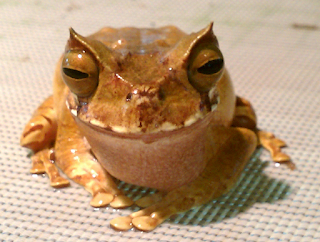Species Spotlight: Gaige's rain frog

There are so many more amphibians in our Frogs of Panama exhibit than any other at the Garden. In fact, we started with just over 20 adult frogs (3 Anotheca spinosa , 4 Incilius coniferus , 4 Pristimantis gaigei and 10 Colostethus pratti ), and since then, at least 2 of these Panamanian species have reproduced in the exhibit! Every morning the calls of male Rocket frogs ( Colostethus ) can be heard as they woo prospective mates. The males can also be seen competing for territory in typical poison frog fashion if you watch closely and stay very still. Although Rocket frogs are technically in the family of 'poison frogs', they seem to rely more on their quickness (they are called 'rocket frogs', after all) and their cryptic coloration, rather than being brightly colored, as is typical with their poison frog relatives. Pristimantis gaigei | Gaige's rain frog — breeding in the Frogs of Panama exhibit Last Tuesday, I noticed a pair of adult Rain frogs ( Pri





